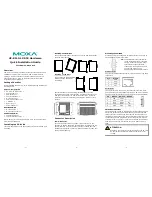
Page 4
TG0048A
Section 3: Basic Troubleshooting
C. Basic Troubleshooting
1.
Inspect charging system components
Check connections at ground cables, positive
cables, and regulator harness. Repair or replace
any damaged component before troubleshooting.
2.
Inspect connections of vehicle batteries
Connections must be clean and tight.
3.
Determine battery type, voltage, and state
of charge
Batteries must be all the same type for system
operation. If batteries are discharged, recharge
or replace batteries as necessary. Electrical
system cannot be properly tested unless batter-
ies are charged 95% or higher. See page 1 for
details.
4.
Connect meters to alternator
Connect red lead of DMM to alternator B+
terminal and black lead to alternator B–
terminal. Clamp inductive ammeter on B+
cable.
5.
Operate vehicle
Observe charge voltage.
If charge voltage is above
33 volts, immediately shut
down system. Electrical
system damage may occur
if charging system is
allowed to operate at
excessive voltage. Go to
Table 4 at left.
If voltage is at or below regulator setpoint, let
charging system operate for several minutes to
normalize operating temperature.
6.
Observe charge volts and amps
Charge voltage should increase and charge amps
should decrease. If charge voltage does not in-
crease within ten minutes, continue to next step.
7.
Batteries
are considered fully charged if charge
voltage is at regulator setpoint and charge amps
remain at lowest value for 10 minutes.
8.
If charging system
is not performing properly,
go to Chart 1, page 6.
A. Tools and Equipment for Job
• Digital Multimeter (DMM)
• Ammeter (digital, inductive)
• Jumper wires
If no tools are available, monitor LED code.
B. Identi
cation Record
List the following for proper troubleshooting:
Alternator model number ______________________
Regulator model number ______________________
T
T
CAUTION
SYMPTOM
ACTION
TABLE 4 – System Conditions
Check: loose drive belt; low bat-
tery state of charge.
Check: current load on system
is greater than alternator
can produce.
Check: defective wiring or poor
ground path.
Check: defective alternator
and/or regulator.
Check: defective regulator.
Check: alternator.
Check: presence of energize sig-
nal to IGN terminal on regula-
tor.
Check: battery voltage at alter-
nator output terminal.
Check: defective alternator
and/or regulator.
Low Voltage Output
High Voltage Output
No Voltage Output
R
Section 3: Basic Troubleshooting
Page 4
TG48B

























